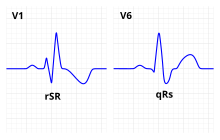Right bundle branch block
| Right bundle branch block | |
|---|---|
intraventricular septum | |
 | |
| ECG characteristics of a typical RBBB showing wide QRS complexes with a terminal R wave in lead V1 and a prolonged S wave in lead V6. | |
| Specialty | Cardiology |
| Types | complete right bundle branch block (CRBBB) incomplete right bundle branch block (IRBBB) |
A right bundle branch block (RBBB) is a
During a right bundle branch block, the right
Incomplete right bundle branch block
An incomplete right bundle branch block (IRBBB) is a conduction abnormality in the right bundle branch block. While a complete RBBB has a QRS duration of 120 ms or more, an incomplete RBBB has a wave duration between 100 and 120 ms. It has a relatively high prevalence, a study conducted on young Swiss military conscripts with a mean age of 19 years found a prevalence of 13.5%.[2] It affects patients of all ages, more commonly males and athletes, however it is not always a benign finding. Therefore, if abnormalities are detected on the physical exam, further testing should be done to exclude heart disease.[3]
There is no consensus in the literature regarding criteria for diagnosis. However, according to the
- QRS wave duration between 100 and 120 ms.
- rsr, rsR, or rSR in leads V1 or V2.
- S wave of longer duration than R wave or greater than 40 ms in leads I and V6.
- Normal R wave peak time in both V5 and V6, but greater than 50 ms in V1.
The first three criteria are needed for diagnosis. The fourth is needed when a pure dominant R waver is present on V1.[3]
Causes
Common causes include normal variation, changes in bundle branch structure - such as mechanical stretching, chest trauma,
Causes for incomplete right bundle branch block (IRBBB) often involve exercise-induced right ventricular remodeling, increased right ventricular (RV) free wall thickness, especially in athletes due to prolonged endurance exercise.[8]
Diagnosis
The criteria to diagnose a right bundle branch block on the
- The heart rhythm must originate above the ventricles (i.e., sinoatrial node, atria or atrioventricular node) to activate the conduction system at the correct point.
- The QRS duration must be more than 100 ms (incomplete block) or more than 120 ms (complete block).[9]
- There should be a terminal R wave in lead V1 (often called "R prime," and denoted by R, rR', rsR', rSR', or qR).
- There must be a prolonged S wave in leads I and V6 (sometimes referred to as a "slurred" S wave).
The T wave should be deflected opposite the terminal deflection of the QRS complex. This is known as appropriate T wave discordance with bundle branch block. A concordant T wave may suggest ischemia or myocardial infarction.[citation needed]
Treatment
The underlying condition may be treated by medications to control hypertension or diabetes, if they are the primary underlying cause. If coronary arteries are blocked, an invasive coronary angioplasty may relieve the impending RBBB.[10]
Epidemiology
Prevalence of RBBB increases with age due to changes in the heart's conduction system. It's estimated up to 11.3% of the population by the age of 80 have RBBB.[11]
Gallery
-
RBBB with associated first degree AV block
-
RBBB with associated tachycardia
-
RBBB
See also
References
- ^ "Conduction Blocks". Department of Physiology. Kansas City University of Medicine & Biosciences. 2006. Archived from the original on 9 May 2009. Retrieved 20 January 2009.
- PMID 23102624.
- ^ S2CID 235368614.
- ISBN 978-1-4377-2788-3.
- ^ "Chagas Disease: What U.S. Clinicians Need to Know". Centers for Disease Control and Prevention. CDC. Retrieved 3 October 2023.
- PMID 29897909.
- PMID 32640959.
- S2CID 235368614.
- ^ Yanowitz FG. "Lesson VI - ECG Conduction Abnormalities". University of Utah School of Medicine. Archived from the original on 26 January 2008. Retrieved 2009-01-07.
- ^ "Right Bundle Branch Block". Symptoma. Retrieved 2015-08-13.
- PMID 29939649. Retrieved 2022-02-24.




